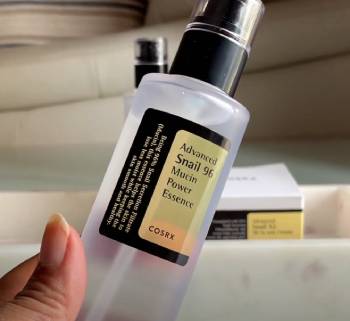At 35, my skin was dull, dry, and screaming for hydration. Snail mucin and hyaluronic acid serums promised a dewy glow, but which one’s better?
I tested both for 30 days, comparing results, feel, and value. In this journey, I share my experience to help you pick the perfect hydrator for your skin.
With a conversational vibe and analytical lens, I’ll unpack their features, pros, and cons to guide your skincare choice.
Comparison Table: Snail Mucin Vs. Hyaluronic Acid
| Feature | Snail Mucin | Hyaluronic Acid |
| Key Ingredient | Snail secretion filtrate | Sodium hyaluronate |
| Primary Benefits | Hydration, repair, brightening | Deep hydration, plumping |
| Texture | Lightweight, slightly sticky | Lightweight, watery or gel-like |
| Skin Types | All, especially sensitive | All, especially dry |
| Application | Serum or essence, day/night | Serum, day/night |
| Price Range | $10–$30 (1.7 oz) | $8–$50 (1 oz) |
| Sourcing | Cruelty-free snail farms | Synthetic or plant-based |
| Best For | Sensitive skin, redness relief | Dry skin, fine lines |
My Skincare Adventure Begins
Last summer, my skin was a mess—flaky patches, redness, and fine lines that mocked my “youthful” vibe.
TikTok was buzzing about snail mucin, while my derm friend swore by hyaluronic acid. Intrigued by snail mucin’s K-beauty hype and hyaluronic acid’s hydration rep, I decided to test both.
For 30 days each, I applied a serum daily, tracking hydration, texture, and glow. My goal? Find a hydrator that fits my sensitive, dry skin and busy life. Here’s what I learned.
Snail mucin, aka snail secretion filtrate, is a K-beauty star packed with hyaluronic acid, glycoproteins, and antioxidants.
Hyaluronic acid, a humectant, draws water into the skin, holding 1,000 times its weight. Both promise hydration but differ in delivery and extras.
Snail mucin repairs and soothes, while hyaluronic acid plumps and hydrates. Let’s break down their features and my experience.
Snail Mucin: The K-Beauty Glow Elixir

Snail mucin, harvested from cruelty-free snail farms, is a multitasking serum. Brands like COSRX (96% snail secretion filtrate) blend it with soothing centella asiatica.
A 1.7 oz bottle costs $10–$30, applied as a lightweight essence. It hydrates, repairs damage, fades scars, and calms redness, ideal for sensitive or acne-prone skin.
No snails are harmed, and it’s fragrance-free.
I used COSRX Advanced Snail 96 Mucin Power Essence, applying a dime-sized amount after cleansing. The texture was slippery, slightly sticky, but sank in fast.
It felt cooling, and my skin drank it up. By week two, my redness around my cheeks faded, and my skin felt softer. Fine lines around my eyes softened, and old acne scars looked less angry.
The sticky feel took getting used to, and results were gradual. Studies show snail mucin boosts collagen and heals wounds, which matched my smoother texture.
Users on beauty forums love its soothing power, though some dislike the tackiness. After 30 days, my skin was dewy, and my makeup glided on.
It layered well under moisturizer but needed a few minutes to dry. My sensitive skin had no irritation, a win since I’m prone to flare-ups.
Pros and Cons of Snail Mucin

Pros of Snail Mucin:
- Multitasking: Hydrates, repairs, and brightens in one step.
- Sensitive-skin friendly: Calms redness and irritation.
- Lightweight: Layers easily in routines.
- Budget-friendly: $10–$30 for long-lasting bottles.
Cons of Snail Mucin:
- Sticky texture: Slight tackiness can feel odd.
- Gradual results: Takes 2–3 weeks for noticeable changes.
- Scent concern: Mild natural odor may bother some.
- Animal-derived: May not suit vegans despite cruelty-free claims.
Hyaluronic Acid: The Hydration Heavyweight

Hyaluronic acid (HA), often as sodium hyaluronate, is a humectant in serums like The Ordinary’s Hyaluronic Acid 2% + B5. A 1 oz bottle costs $8–$50, applied post-cleansing.
It pulls moisture from the air or deeper skin layers, plumping fine lines and hydrating dry skin. It’s synthetic or plant-based, fragrance-free, and suits all skin types, especially dry or aging skin.
I used The Ordinary’s HA serum, applying four drops morning and night. The watery texture absorbed instantly, leaving no residue.
By day seven, my skin felt bouncy, and flakiness vanished. Fine lines on my forehead looked less pronounced, likely from HA’s plumping effect. A 2021 study confirms HA improves skin hydration and elasticity.
My skin stayed hydrated all day, even in my dry office. The dropper was messy, and I needed a moisturizer to lock it in.
HA is a one-trick pony—hydration without repair or brightening. Users praise its versatility, though some find it drying without a moisturizer in low-humidity climates.
After 30 days, my skin was plump and smooth, but redness and scars didn’t improve. It layered seamlessly with sunscreen and makeup, perfect for my morning rush.
Pros and Cons of Hyaluronic Acid
Pros of Hyaluronic Acid
- Intense hydration: Plumps skin and smooths fine lines.
- Universal appeal: Works for all skin types, no irritation.
- Fast-absorbing: Watery texture sinks in quickly.
- Affordable options: Budget brands like The Ordinary deliver.
Cons of Hyaluronic Acid
- Hydration-only: Lacks repair or brightening benefits.
- Needs moisturizer: Can dry out without sealing in moisture.
- Messy applicators: Droppers can be imprecise.
- Humidity-dependent: Less effective in dry climates.
Also Read: My Experience With Loved01 Skincare
The Science: How They Hydrate
Snail mucin and hyaluronic acid both hydrate, but their mechanisms differ.
Snail mucin contains natural HA, peptides, and antioxidants, promoting hydration, collagen production, and wound healing.
A 2022 study found it reduces inflammation and boosts skin barrier function, ideal for sensitive skin.
Its glycoproteins repair damage, fading scars and redness over time.
Hyaluronic acid is a pure humectant, drawing water to the skin’s surface. It’s found naturally in our skin but depletes with age.
Studies show topical HA increases hydration and elasticity, especially in dry skin, but it doesn’t repair or brighten. Low-molecular-weight HA penetrates deeper, while high-molecular-weight HA sits on top, plumping instantly.
Both are non-comedogenic, but HA needs a moisturizer to lock in benefits, unlike snail mucin’s all-in-one formula.
My Skin’s Transformation

Snail mucin became my evening ritual. I applied it after cleansing, letting it sink in before moisturizer.
The sticky feel faded fast, and my skin felt soothed. By week three, my redness was barely noticeable, and my acne scars softened.
My skin barrier felt stronger—no tightness after washing. The $20 bottle lasted two months, a steal for daily use.
It worked with my gentle cleanser and didn’t clog pores, even during humid days.
Hyaluronic acid was my morning go-to. Four drops after cleansing left my skin plump and ready for sunscreen.
Flakiness disappeared, and my makeup looked flawless—no caking around dry patches. The $8 bottle lasted a month, but I needed a rich moisturizer to seal it in.
My fine lines looked less obvious, but redness and scars stayed put. It was a hydration champ but didn’t address my sensitive skin’s needs.
Head-to-Head: Hydration, Repair, and Routine
Snail mucin was my sensitive-skin savior. Its soothing, repairing powers tackled redness and scars while hydrating.
The sticky texture was a small price for the glow, and the price was right. It fit my evening routine, layering well with moisturizer and retinol.
If you have sensitive or acne-prone skin and want a multitasker, snail mucin’s your pick.
Hyaluronic acid was a hydration hero. Its instant plumping and lightweight feel were perfect for my dry skin and morning rush.
It didn’t calm redness or fade scars, and I needed a moisturizer to maximize it. If you’re battling dryness or fine lines and love simplicity, HA’s your match.
It’s versatile but lacks snail mucin’s repair benefits.
Also Read: My Experience With The Spa Dr. Skin Care
Tips for Success
Apply snail mucin or HA on damp skin post-cleansing for max absorption. Use snail mucin at night to let it work its magic, and HA morning or night for hydration.
Follow with a moisturizer to lock in benefits—crucial for HA. Start with a patch test, especially for snail mucin, if you’re sensitive.
Use 3–4 drops of HA or a dime-sized amount of snail mucin to avoid overdoing it.
I applied snail mucin after a hydrating toner, letting it dry before moisturizer. HA went on before sunscreen, paired with a creamy moisturizer.
I stored both in a cool, dry drawer to preserve potency. Consistency was key—daily use for 8 weeks showed the best results.
Check with a derm if you’re on actives like retinol to avoid irritation.
Addressing the Hype
Snail mucin’s K-beauty fame and hyaluronic acid’s derm-backed rep have made them skincare stars.
Snail mucin’s repair and soothing claims draw sensitive-skin folks, while HA’s hydration appeals to dry or aging skin.
Both deliver, but neither’s a miracle. Cleanse, moisturize, and wear sunscreen to amplify results.
Online reviews love snail mucin’s glow and HA’s plumpness, but some dislike snail mucin’s texture or HA’s need for extra steps.
My skin loved both, but their strengths suited different needs.
Also Read: My Thoughts On Vivant Skin Care
Frequently Asked Questions (FAQs)
Snail mucin is better for sensitive skin and repair; hyaluronic acid excels for dry skin and plumping. It depends on your goals.
Yes, layer HA first for hydration, then snail mucin for repair. Use on damp skin and follow with moisturizer.
Some derms recommend snail mucin for its soothing and repairing benefits, especially for sensitive or acne-prone skin.
Avoid combining snail mucin with harsh actives like high-strength retinol or acids to prevent irritation. Patch test first.
Final Thoughts
I’ve shared my 60-day journey with snail mucin and hyaluronic acid to light your skincare path.
Snail mucin soothed my redness and repaired my skin, while hyaluronic acid plumped and hydrated like a dream. You deserve a hydrator that fits your skin—sensitive or dry.
Pick snail mucin for repair and glow, hyaluronic acid for deep hydration, or layer both. Grab a serum and unlock your dewy skin—you’ve got this!



